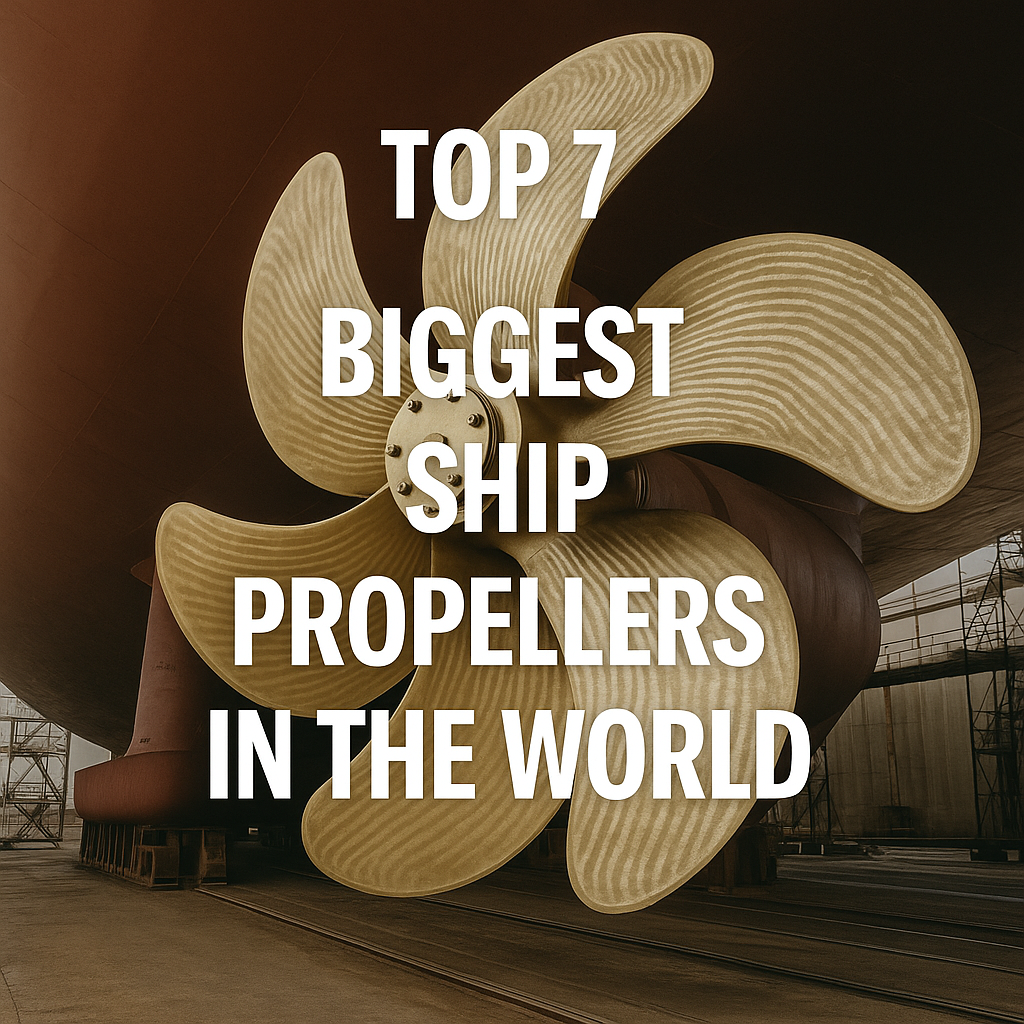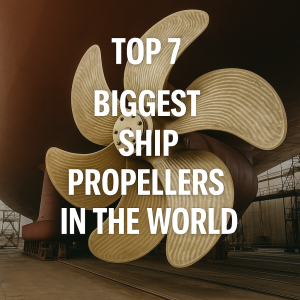Explore the top 7 biggest ship propellers in the world—massive engineering marvels driving supertankers and megaships. Learn about their construction, purpose, and role in maritime innovation.
Why Massive Ship Propellers Matter in Modern Maritime Operations
In the complex world of global shipping, it’s easy to be awed by the towering hulls and sprawling cargo bays of the largest ships. But beneath the waterline lies a component just as critical—the ship’s propeller. Often overlooked, these underwater giants are responsible for converting engine power into thrust, propelling ships weighing hundreds of thousands of tonnes across oceans.
The size and design of a propeller have a direct impact on a vessel’s fuel efficiency, maneuverability, vibration levels, and carbon emissions. For large container ships, LNG carriers, and oil tankers, maximizing propulsion efficiency means millions in fuel savings and significant reductions in greenhouse gas emissions. According to the International Maritime Organization (IMO), propulsion systems account for over 85% of a ship’s fuel consumption profile, highlighting the propeller’s central role in the maritime decarbonization journey.
Let’s dive into the engineering marvels behind the world’s largest ship propellers and the vessels they serve.
Top 7 Biggest Ship Propellers in the World
1. Emma Mærsk (Denmark)
Propeller Diameter: 9.6 meters
Material: Nickel-aluminum-bronze alloy
Weight: 131 tonnes
Ship Type: Ultra Large Container Ship (ULCS)
Manufacturer: Wärtsilä
Emma Mærsk, once the largest container ship globally, features a single, seven-blade fixed-pitch propeller. This massive piece of precision engineering works in tandem with a Wärtsilä-Sulzer 14RT-Flex96C engine, producing over 80,000 kW. Its massive size optimizes hydrodynamic flow to minimize vibration and maximize fuel economy.
2. Oasis of the Seas (USA)
Propeller Diameter: 6.1 meters (Azipods)
Type: ABB Azipod (Electric Azimuth Thrusters)
Total Propulsion Power: 20 MW per pod
Ship Type: Cruise Ship
Rather than a traditional shaft line, Oasis of the Seas uses three ABB Azipods—gearless, steerable propulsion units. Each Azipod integrates an electric motor that directly turns the propeller. These units offer 360-degree maneuverability and reduce fuel consumption by up to 15%, according to ABB’s data. They represent a different philosophy: smaller diameter, but more dynamic control and reduced hull resistance.
3. HMM Algeciras (South Korea)
Propeller Diameter: 10.6 meters
Weight: 104 tonnes
Ship Type: Mega Container Ship
Manufacturer: Hyundai Heavy Industries
HMM Algeciras, the world’s largest container ship by capacity (23,964 TEU), features a massive fixed-pitch propeller designed to operate at slower rotational speeds. This improves propulsion efficiency at sea while reducing cavitation and acoustic pollution—key considerations in modern vessel design.
4. Pioneering Spirit (Switzerland)
Propeller System: 8 Azimuth Thrusters
Total Power Output: 95 MW
Ship Type: Heavy Lift / Offshore Construction
Manufacturer: Rolls-Royce Marine
While not one single massive propeller, the Pioneering Spirit’s propulsion system collectively makes it one of the most powerful at sea. The thrusters provide dynamic positioning capability for this unique ship, which lifts entire oil platforms. The propeller units, each several meters in diameter, demonstrate how modular propulsion solutions are replacing traditional configurations.
5. CMA CGM Jacques Saadé (France)
Propeller Diameter: 10.5 meters
Weight: ~100 tonnes
Ship Type: LNG-powered Container Ship
Manufacturer: MAN Energy Solutions
The world’s first LNG-powered ultra-large container vessel, Jacques Saadé, features a massive, slow-rotating propeller optimized for the vessel’s dual-fuel propulsion system. Its size reduces hydrodynamic losses and works in sync with air lubrication systems under the hull for enhanced efficiency.
6. TI Europe (Belgium)
Propeller Diameter: 9 meters
Weight: 95 tonnes
Ship Type: Ultra Large Crude Carrier (ULCC)
Manufacturer: MAN Diesel & Turbo
The TI class supertankers—once the largest oil tankers in the world—use slow-speed diesel engines and large fixed-pitch propellers. The immense propeller blades are designed to move the ship’s vast 440,000 DWT through the water with minimal vibration, ensuring smoother cargo transport over long distances.
7. Queen Mary 2 (UK)
Propeller Type: 4 Fixed-pitch pods
Propeller Diameter: ~5.5 meters
Ship Type: Ocean Liner
Manufacturer: Rolls-Royce
A unique mix of tradition and innovation, Queen Mary 2 uses four pods—two fixed and two steerable. While smaller than others on this list, the configuration offers superior maneuverability and performance in open ocean and confined ports alike. The fixed blades are designed to reduce wake and cavitation for passenger comfort.
–
Key Technologies and Advancements in Propeller Design
Blade Shape Optimization
Computational Fluid Dynamics (CFD) now allows shipbuilders to simulate and test blade designs virtually. New blade shapes—such as scimitar profiles—maximize thrust and reduce drag.
Cavitation Control
Large propellers are prone to cavitation (formation of vapor bubbles), which can damage blades and reduce efficiency. Today’s solutions include variable pitch control, special blade coatings, and wake-equalizing ducts.
High-Efficiency Alloys
The use of nickel-aluminum-bronze alloys and composite materials ensures strength and resistance to corrosion, even in harsh environments.
Smart Propulsion Systems
Sensors embedded within the hub transmit torque, vibration, and strain data in real time, helping ship operators optimize propulsion for fuel economy and predictive maintenance.
Challenges and Solutions in Designing Giant Propellers
Manufacturing Tolerances
Creating a 100-tonne propeller with precise aerodynamic geometry is extremely challenging. Minor imbalances can cause severe vibration or energy loss.
Solution: Advanced CNC machining, laser alignment tools, and non-destructive testing (NDT) are used to achieve micron-level accuracy.
Vibration and Noise
Large blades at slow speeds can resonate and generate underwater noise, which affects marine life and crew comfort.
Solution: Asymmetrical blade shapes and wake-equalizing ducts are used to reduce turbulence and noise output.
Retrofitting for Efficiency
Older ships often operate with suboptimal propellers. However, replacing a ship’s propeller involves dry-docking and major reconfiguration.
Solution: Modular retrofit kits and CFD-assisted design upgrades make replacements more cost-effective and less invasive.
Case Study: CMA CGM Jacques Saadé’s LNG-Efficient Propulsion
In 2020, CMA CGM launched Jacques Saadé, its flagship vessel for sustainability. The ship’s massive 10.5-meter propeller was co-developed with MAN Energy and optimized for LNG fuel. The design was tested using CFD simulations and towing tanks in France. The result: a 20% reduction in CO₂ emissions per container moved and a quieter, more stable voyage—proving that propeller size, when paired with intelligent design, is key to greener shipping.
FAQ: Biggest Ship Propellers
1. What is the largest ship propeller ever built?
The Emma Mærsk’s 9.6-meter propeller was once considered the largest single fixed-pitch propeller. However, newer vessels like HMM Algeciras feature even larger systems, exceeding 10 meters in diameter.
2. Why are larger propellers more efficient?
Larger propellers rotate more slowly, reducing cavitation and increasing thrust efficiency. This is essential for large ships that operate continuously over long distances.
3. What materials are used to build large propellers?
Nickel-aluminum-bronze alloys are most common due to their strength, corrosion resistance, and machinability.
4. How are propeller vibrations minimized?
Using CFD simulations, asymmetrical blade designs, and elastic mounting systems all help reduce harmful vibration and underwater noise.
5. Can propellers be upgraded for efficiency?
Yes. Many shipowners replace older propellers with optimized designs, often leading to fuel savings of 5–15% depending on the vessel.
6. How do azimuth thrusters differ from traditional propellers?
Azimuth thrusters can rotate 360 degrees and include the propulsion motor inside the unit. They offer better maneuverability and eliminate the need for rudders.
Conclusion: The Power Beneath the Hull
From container giants to oil supertankers, modern maritime operations depend on the massive, precisely engineered propellers that power them across the globe. These propellers—some weighing over 100 tonnes—are critical not just for movement, but for efficiency, sustainability, and safety.
As the maritime industry pivots toward lower emissions and digital integration, propeller design will play a central role. Whether it’s a fixed-pitch titan like the one on HMM Algeciras or a smart azimuth unit on a cruise liner, the future of shipping will be driven by what lies beneath.
References
-
Wärtsilä. (2024). Marine Propulsion Solutions. https://www.wartsila.com
-
IMO. (2023). Reducing GHG Emissions from Ships. https://www.imo.org
-
ABB Marine. (2023). Azipod Propulsion Systems. https://new.abb.com
-
MAN Energy Solutions. (2023). Propeller Design & LNG Systems. https://www.man-es.com
-
Lloyd’s List Intelligence. (2024). Ship Design and Propulsion Trends. https://lloydslist.maritimeintelligence.informa.com
-
Royal Institution of Naval Architects (RINA). (2023). Propeller Efficiency Research Papers. https://www.rina.org.uk
-
MarineTraffic. (2024). Live Fleet and Vessel Specifications. https://www.marinetraffic.com


